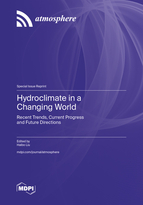Hydroclimate in a Changing World: Recent Trends, Current Progress and Future Directions
A special issue of Atmosphere (ISSN 2073-4433). This special issue belongs to the section "Climatology".
Deadline for manuscript submissions: closed (15 April 2023) | Viewed by 24763
Special Issue Editor
Interests: climate variability and climate change; hydroclimate variability and change; droughts and floods; high-resolution numerical weather prediction
Special Issues, Collections and Topics in MDPI journals
Special Issue Information
Dear Colleagues,
Global warming is imposing tremendous challenges upon human lives and other life on Earth. A warmer atmosphere holds more moisture. The consensus is that the moisture transport by the atmospheric circulation strengthens and makes already wet areas of moisture convergence wetter and already dry areas of moisture divergence drier. Therefore, the tropics and mid to high latitudes will get wetter and the subtropics will get drier. Without any change in the interannual variability of hydroclimate, the change in the mean hydroclimate would increase drought risk in some places and flood risk in other places and this would be even. However, global warming will cause the interannual variability of the hydroclimate to intensify, which will induce more droughts and floods. Furthermore, the changing atmospheric circulation interaction with the land surface may cause the changing of storm tracks, and may plays an important role in shaping the moisture redistribution.
This Special Issue serves as a convenient platform for the community to document and discuss the hydroclimate response of global warming. Topics include, but are not limited to:
- Recent and future hydroclimatic extremes;
- Hydroclimate dynamics;
- Hydroclimate variability;
- Food and water security under a changing climate;
- Drought and flood under a changing climate.
Your participation is highly appreciated.
Dr. Haibo Liu
Guest Editor
Manuscript Submission Information
Manuscripts should be submitted online at www.mdpi.com by registering and logging in to this website. Once you are registered, click here to go to the submission form. Manuscripts can be submitted until the deadline. All submissions that pass pre-check are peer-reviewed. Accepted papers will be published continuously in the journal (as soon as accepted) and will be listed together on the special issue website. Research articles, review articles as well as short communications are invited. For planned papers, a title and short abstract (about 100 words) can be sent to the Editorial Office for announcement on this website.
Submitted manuscripts should not have been published previously, nor be under consideration for publication elsewhere (except conference proceedings papers). All manuscripts are thoroughly refereed through a single-blind peer-review process. A guide for authors and other relevant information for submission of manuscripts is available on the Instructions for Authors page. Atmosphere is an international peer-reviewed open access monthly journal published by MDPI.
Please visit the Instructions for Authors page before submitting a manuscript. The Article Processing Charge (APC) for publication in this open access journal is 2400 CHF (Swiss Francs). Submitted papers should be well formatted and use good English. Authors may use MDPI's English editing service prior to publication or during author revisions.
Keywords
- climate variability
- climate change
- hydroclimate variability
- droughts
- floods
- storms
- storm track
- precipitation
- aridification






